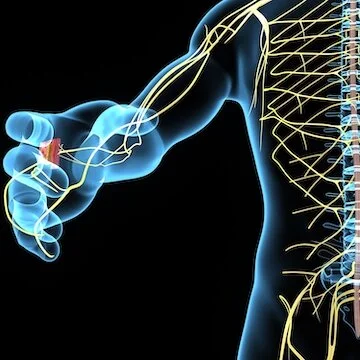Peripheral Nervous System: the portion of the nervous system outside the brain and spinal cord. It includes the nerves of the trunk and limbs. (Fields, 318) Brings messages from the “somatosensory receptors” to the spinal cord and brain. Carries messages from the brain and spinal cord to the muscles and glands. This system was long known to be plastic, if you cut a nerve in your hand, it can “regenerate” or heal itself. (Doidge, 53) Has autonomic and somatic divisions. The “autonomic nervous system” includes the “enteric,” “parasympathetic,” and “sympathetic” subdivisions. The “somatic nervous system” includes the “cranial” and “spinal nerves” and their “ganglia,” and the “sensory receptors.” (MeSH)
Autonomic Nervous System: part of the nervous system serving organs, which control the normally involuntary functions of the body. (Oxford) Responsible for regulating organ function and metabolism. Responsible for “homeostasis.” (Blakeslee, 182, 211) The “heart,” the “stomach,” and (the) “intestines” are regulated by the autonomic nervous system (Chudler, 33) Regulates involuntary functions, such as “heartbeat,” “blood pressure,” “breathing,” and digestion. These processes occur with little or no conscious involvement. Emotions and mental imagery also influence (the) autonomic nervous system. A peaceful mental image can lower many autonomic functions. (Hockenbury, 52-53) (Cells in this system) perform their functions below the conscious level. Two neurons are required to effect a “contraction” of smooth muscle or cardiac muscle, or to elicit secretion from the cell of a gland. The “cell body” of the first neuron is in the central nervous system, whereas the cell body of the second neuron is in the peripheral nervous system. (Patestas, 118)
Enteric Nervous System: situated completely within the wall of the digestive tract and controls the entire process of digestion. (Patestas, 9) (Includes) a neural "plexus," lying within the walls of the gut, that is involved in controlling ‘peristalsis’ (muscular contractions) and “gastrointestinal” “secretions.” (Blumenfeld, 24) ‘Innervates’ (stimulates with nerve impulses) the gastrointestinal tract, the pancreas, and the gallbladder. It contains sensory neurons, interneurons, and motor neurons. Thus the (pathway) can autonomously sense the tension and the chemical environment in the gut and regulate blood vessel tone, (motion), secretions, and fluid transport. The system is itself governed by the central nervous system and receives both parasympathetic and sympathetic innervation. (MeSH)
Parasympathetic Nervous System: the ‘rest and digest’ part of the autonomic nervous system. (Blakeslee, 182) Generally acts to conserve resources and restore homeostasis. (MeSH) In times when there is no emergency, it works to save energy - blood pressure decreases, heartbeat slows, and digestion can start. (Chudler, 35) Helps the body conserve energy. (Hockenbury, 53)
Sympathetic Nervous System: the "fight or flight" part of the autonomic nervous system which gets the body revved up and ready for violence or intense physical (or emotional) activity. (Blakeslee, 215) The part of the nervous system that increases heart rate, blood pressure, breathing rate, and pupil size. It also causes blood vessels to narrow and decreases digestive juices. (NCIt) When you feel threatened the following happens: heart beats faster; breathing quickens; blood is diverted to your muscles and lungs; mouth dries up; pupils contract; senses focus outward. (Blakeslee, 182) Arouses the body to expend energy. (Hockenbury, 53)
Somatic Nervous System: responsible for voluntary muscle control, touch, and “propriorception.” Relays motor commands from the brain to the muscles. Sends feedback information from somatosensory receptors back to the brain. (Blakeslee, 182) Communicates sensory information to the central nervous system and carries motor messages from the central nervous system to the muscles. (Hockenbury, 52) In this system, only a single neuron is required to relay the signal for muscle contraction. (Patestas, 118)
